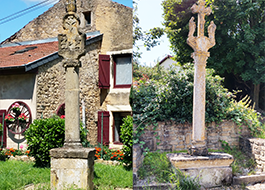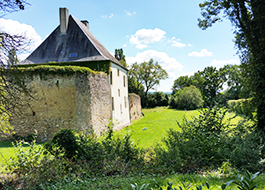Puttelange-lès-Thionville
Durée visite : 30 minutes
Moyen : Pédestre
Il est fait mention de Puttelange dans une charte de l’an 907. Charte par laquelle Vodelbertus, prêtre, fait don à l’abbaye d’Echternach des biens qu’il possédait à Puttelange. À Puttelange se trouve un petit château qui a été construit en 1653 par Thomas Ryaville. La commune de Puttelange-lès-Thionville est une ancienne seigneurie luxembourgeoise. L’activité économique principale a été centrée sur la carrière de grès. On y extrayait des pavés et du sable. Ils ont servi dans la construction des routes, l’approvisionnement des hauts fourneaux . Par la suite, on les employa dans la construction des fortifications de la ligne Maginot. Cette ligne défensive était distante d’une dizaine de kilomètres, pour exemple l’ouvrage de l’Immerhof à Hettange, la grande ligne de forts installé dans les bois de Cattenom. Au XIXe siècle, les grès de Puttelange sont aussi réputés que ceux de la carrière de Hettange-Grande. Ils ont servi au développement urbain de différentes villes de Moselle, notamment de la ville de Metz.
Mention is made of Puttelange in a charter of the year 907. Charter by which Vodelbertus, priest, donates to the abbey of Echternach the goods he owned in Puttelange. In Puttelange there is a small castle which was built in 1653 by Thomas Ryaville. The commune of Puttelange-lès-Thionville is a former Luxembourg seigneury. The main economic activity has been centered on the sandstone quarry. Cobblestones and sand were quarried there. They were used in the construction of roads, the supply of blast furnaces. Subsequently, they were employed in the construction of the fortifications of the Maginot line. This defensive line was about ten kilometers away, for example the work of the Immerhof in Hettange, the main line of forts installed in the woods of Cattenom. In the 19th century, the sandstones from Puttelange were as famous as those from the Hettange-Grande quarry. They were used for the urban development of various cities of Moselle, in particular of the city of Metz.
Puttelange wird in einer Charta des Jahres 907 erwähnt. Charta, mit der der Priester Vodelbertus der Abtei von Echternach die Waren spendet, die er in Puttelange besaß. In Puttelange befindet sich eine kleine Burg, die 1653 von Thomas Ryaville erbaut wurde. Die Gemeinde Puttelange-lès-Thionville ist eine ehemalige luxemburgische Regierung. Die Hauptwirtschaftsaktivität konzentrierte sich auf den Sandsteinbruch. Kopfsteinpflaster und Sand wurden dort abgebaut. Sie wurden beim Bau von Straßen und bei der Lieferung von Hochöfen eingesetzt. Anschließend wurden sie beim Bau der Befestigungen der Maginot-Linie eingesetzt. Diese Verteidigungslinie war etwa zehn Kilometer entfernt, zum Beispiel die Arbeit des Immerhofs in Hettange, der Hauptfestungslinie in den Wäldern von Cattenom. Im 19. Jahrhundert waren die Sandsteine aus Puttelange ebenso berühmt wie die aus dem Steinbruch Hettange-Grande. Sie wurden für die Stadtentwicklung verschiedener Städte der Mosel, insbesondere der Stadt Metz, verwendet.

D’or à trois pals de gueules.
Ce sont les armes des Puttelange, d’ancienne chevalerie.
Or with three pals Gules.
These are the arms of the Puttelange, of ancient chivalry.
Oder mit drei Freunden Gules.
Dies sind die Arme des Puttelange, der alten Ritterlichkeit.

Die Bohnefresser (Bohnenfresser) = les bouffeurs de haricots.
Pendant presque toute l’année, les haricots verts ou secs sont le légume préféré des habitants de ce village.
Le terme « bouffeurs » est l’expression rustique pour mangeurs; nous y avons aussi une preuve du grand appétit des gens de Puttelange.
Réf. Archives municipales de Thionville (Liste de M. L. V.) – Liste de M. L. B.
Die Bohnefresser (Bohnenfresser) = the bean eaters.
For most of the year, green or dried beans are the favorite vegetable of the inhabitants of this village. The term « eaters » is the rustic expression for eaters; we also have proof of the great appetite of the people of Puttelange.
Ref. Municipal Archives of Thionville (List of M. L. V.) – List of M. L. B.
Die Bohnefresser = die Bohnenfresser.
Während des größten Teils des Jahres sind grüne oder getrocknete Bohnen das Lieblingsgemüse der Bewohner dieses Dorfes. Der Begriff « Esser » ist der rustikale Ausdruck für Esser; Wir haben auch Beweise für den großen Appetit der Menschen in Puttelange.
Ref. Stadtarchiv von Thionville (Liste von M. L. V.) – Liste von M. L. B.

Les habitants et le habitantes de Puttelange-lès-Thionville s’appellent les Puttelangeois et les Puttelangeoises.
The inhabitants of Puttelange-lès-Thionville are called Puttelangeois and Puttelangeoises.
Die Einwohner von Puttelange-lès-Thionville heißen Puttelangeois und Puttelangeoises.
Les points de visites
.
Le nom de Bildstock désigne en Allemagne occidentale, en Autriche, en Moselle germanophone et en Alsace une sculpture religieuse. Elle est située aussi bien en bordure de chemin qu’en façade d’édifices. On peut la retrouver près d’édifices civils comme les lavoirs. Il est le plus souvent composé d’un socle. Ce dernier supporte un fût coiffé d’un élément cubique comportant quatre niches sculptées. Les sculptures représentent des saints avec leurs attributs, le tout surmonté parfois d’une croix. Le Bildstock peut aussi avoir la forme d’une petite chapelle cubique surmontée d’un toit. Le terme a été proposé pour la première fois par monsieur Kieffer en 1934. Il reprenait un terme d’origine allemande à savoir une image ou bild sur un bâton ou stock. Il s’agissait d’une croix de chemin tout à fait particulière, destinée à être vue sur quatre ou voire trois côtés. Aux XVe et XVIe siècles, le fût lorsqu’il est conservé, nous indique la profession du commanditaire par un attribut professionnel. Au début du XVIIe siècle la dédicace est le plus souvent écrite.
The name of Bildstock designates in Western Germany, Austria, German-speaking Moselle and Alsace a religious sculpture. It is located both at the edge of the road and in front of buildings. It can be found near civilian buildings such as wash houses. It is most often composed of a base. The latter supports a shaft topped with a cubic element comprising four carved niches. The sculptures represent saints with their attributes, the whole sometimes surmounted by a cross. The Bildstock can also have the shape of a small cubic chapel topped by a roof. The term was first proposed by Mr. Kieffer in 1934. It took over a term of German origin, namely an image or bild on a stick or stock. It was a very special way cross, intended to be seen on four or even three sides. In the 15th and 16th centuries, the barrel when it is preserved, indicates to us the profession of the sponsor by a professional attribute. At the beginning of the 17th century, the dedication was most often written.
Der Name Bildstock bezeichnet in Westdeutschland, Österreich, der deutschsprachigen Mosel und dem Elsass eine religiöse Skulptur. Es befindet sich sowohl am Straßenrand als auch vor Gebäuden. Es befindet sich in der Nähe von zivilen Gebäuden wie Waschhäusern. Es besteht meistens aus einer Basis. Letzterer trägt einen Schaft, der mit einem kubischen Element bestückt ist, das vier geschnitzte Nischen umfasst. Die Skulpturen stellen Heilige mit ihren Attributen dar, wobei das Ganze manchmal von einem Kreuz überragt wird. Der Bildstock kann auch die Form einer kleinen kubischen Kapelle haben, die von einem Dach gekrönt wird. Der Begriff wurde erstmals 1934 von Herrn Kieffer vorgeschlagen. Er übernahm einen Begriff deutschen Ursprungs, nämlich ein Bild oder Bild auf einem Stock oder einer Aktie. Es war ein ganz besonderes Wegkreuz, das auf vier oder sogar drei Seiten zu sehen war. Im 15. und 16. Jahrhundert zeigt uns das Fass, wenn es konserviert ist, den Beruf des Sponsors durch ein professionelles Attribut an. Zu Beginn des 17. Jahrhunderts wurde die Widmung am häufigsten geschrieben.
.
.
À Puttelange se trouve un petit château. Il a été construit en 1653 par Thomas Ryaville. Il y passait jadis une voie romaine qui contournait le château entouré de fossés. La seigneurie de Puttelange avait été de tout temps comptée comme une justicerie. Elle dépendait de la prévôté de Luxembourg. Le maire donna l’ordre en 1779 d’y construire un moulin. Ce beau château est situé dans un vallon au nord de la commune. Un peu à l’écart du village, la famille fondatrice était alliée à la famille des seigneurs de Rodemack. Elle comprend dans sa filiation un musicien et compositeur autrichien. Il s’agit de Jean Vesque de Puttelange ou Johann Vesque von Püttlingen, dit Hoven. Il est né le 23 juillet 1803 et décède le 29 octobre 1883. C’était un avocat autrichien , diplomate, auteur, compositeur et chanteur. Il a entre autre créé Turandot en 2 actes en 1838 et Jeanne d’Arc en 3 actes 1840. Le château de nos jours est une propriété privée, où les abords sont tolérés, mais l’intérieur n’est visitable qu’avec l’autorisation des propriétaires.
In Puttelange there is a small castle. It was built in 1653 by Thomas Ryaville. There used to be a Roman road that went around the castle surrounded by ditches. The seigneury of Puttelange had always been counted as a justice system. It depended on the provost of Luxembourg. The mayor gave the order in 1779 to build a mill there. This beautiful castle is located in a valley to the north of the town. A little away from the village, the founding family was allied with the family of the lords of Rodemack. She includes in her lineage an Austrian musician and composer. It is Jean Vesque de Puttelange or Johann Vesque von Püttlingen, said Hoven. He was born July 23, 1803 and died October 29, 1883. He was an Austrian lawyer, diplomat, author, composer and singer. Among other things, he created Turandot in 2 acts in 1838 and Joan of Arc in 3 acts 1840. The castle nowadays is a private property, where the surroundings are tolerated, but the interior can only be visited with the permission of owners.
In Puttelange gibt es eine kleine Burg. Es wurde 1653 von Thomas Ryaville erbaut. Früher gab es eine Römerstraße, die um die Burg herum führte und von Wassergräben umgeben war. Das Seigneury von Puttelange war immer als Justizsystem gezählt worden. Es hing vom Provost Luxemburgs ab. Der Bürgermeister gab 1779 den Befehl, dort eine Mühle zu bauen. Dieses wunderschöne Schloss befindet sich in einem Tal im Norden der Stadt. Etwas außerhalb des Dorfes war die Gründerfamilie mit der Familie der Herren von Rodemack verbündet. Sie hat einen österreichischen Musiker und Komponisten in ihrer Linie. Es ist Jean Vesque de Puttelange oder Johann Vesque von Püttlingen, sagte Hoven. Er wurde am 23. Juli 1803 geboren und starb am 29. Oktober 1883. Er war ein österreichischer Anwalt, Diplomat, Autor, Komponist und Sänger. Unter anderem schuf er 1838 Turandot in 2 Akten und 1840 Jeanne d’Arc in 18 Akten. Das Schloss ist heutzutage ein Privatbesitz, in dem die Umgebung toleriert wird, aber das Innere kann nur mit dem besichtigt werden Erlaubnis der Eigentümer.







